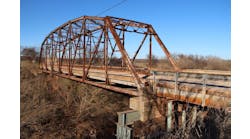The contest is on. The Maine Department of Transportation (MDOT) has invited visitors to their website (www.waldohancockbridge.com/waldo-county-bridge.com) to submit possible names for the new Penobscot River Crossing on U.S. Rte. 1. Suggestions so far include naming the bridge for notable Mainers or the creative use of Native American words or the “Penobscot Narrows Bridge.”
Only time will reveal the name that will come from the process, but just two words sum it up for many who have participated in the public involvement, design and construction of the project: the “Wicked Good” Bridge. This name was submitted by a site visitor, and it is a common expression heard around Maine to describe something that is beyond great. The new bridge is indeed “wicked good” by providing something for everyone, such as a public observatory that will perch high atop the western pylon and the innovative and creative technologies that are being incorporated to provide the maximum ease in maintaining the bridge for a very long time.
In 2004, Roads & Bridges selected the new Penobscot River Bridge as No. 1 in their annual Top 10 Bridges listing. In addition to the public observatory that will be located 420 ft above the river, many other aspects of the bridge feature technical achievements and systems that are unique and technology firsts. The objectives are to maximize the durability of Maine’s first cable-stayed bridge and provide Maine’s coastline with a landmark that will endure well over 100 years. To really sum up all of the innovation in the new bridge you need to start at the beginning, in the summer of 2002.
A bridge worth fighting for
MDOT had originally planned a total rehabilitation of the 70-year-old Waldo-Hancock Bridge. The first project, rehabilitation of the east tower concrete, began in 2000. When the main suspension cables were unwrapped for visual inspection of the individual wires in each of the bridge’s 37 cables in 2001, deterioration was found to have advanced to the point that would not allow the full life of the rehabilitation to be realized.
As MDOT moved to quickly design and construct a replacement structure, it also was determined that loads must be severely limited on the existing bridge. This led the department to an immediate and first-ever strengthening project of the bridge to ensure that it would remain open to traffic on Rte. 1 until a new bridge could be constructed. Secondly, MDOT immediately took decisive steps to quicken the pace of contracting for the design of the replacement bridge. FIGG, Tallahassee, Fla., was selected from a field of 14 engineering firms. A public involvement process was implemented, which encouraged the community to share their visions of their new bridge.
In the evolutionary process of three public workshop meetings, the public learned a great deal about bridge design and experienced numerous realistic visualizations that allowed them to fly around, drive across and ride a boat under potential new bridges. In the end, they heartily endorsed a plan unlike any other—to link the bridge to the adjacent Fort Knox state historic site, Maine’s largest historic fort. The fort features stunning military architecture assembled by master granite craftsmanship. Constructed between 1844 and 1864, it is an unaltered example of a large mid-19th century granite coastal fortification. It also is New England’s finest unmodified specimen of military architecture of the period. The fort was strategically located on the narrows of the Penobscot River to protect the river valley from naval attack. Although it never saw combat, Fort Knox was garrisoned during the Civil and Spanish-American wars.
Visitors to the fort will be provided the opportunity to take a path to the base of the western pylon where they will enter the bridge and take an elevator up to the top of the pylon to a glass public observatory more than 420 ft above the Penobscot River Bridge. To expedite the project, MDOT selected the builder side of the owner-facilitated design-build team in thorough reviews of qualifications, interviews and detailed unit pricing based on conceptual designs. Two of Maine’s largest bridge contractors (Reed & Reed and Cianbro Corp.) teamed to create a joint venture that could quickly mobilize and begin construction.
Right off the water
A foundation design package was approved and released to the selected construction team of Cianbro-Reed & Reed LLC prior to completion of the entire design. This initial package accounted for the overall bridge design and considered estimated loads and conditions.
The owner, designer and construction partners, through a unique form of owner-facilitated design-build contracting method, quickly embraced the fast-track nature of this project. The designer and contractor have separate contracts with the owner, but MDOT, FIGG and Cianbro-Reed & Reed LLC all signed a partnering agreement with each other that formalizes their commitment to work together on the project in a collaborative manner. This was essential toward the goal of completing the design and construction of the bridge in less than 30 months from start to finish. With the challenge of opening the new bridge as quickly as possible, it was determined that by placing the bridge foundation on the river banks, permitting could be streamlined, allowing construction to begin sooner. Had the pylon foundations been in the water, the permit time frame would not have allowed work to begin on the cofferdams for the foundations until about two months after they were complete. Spanning the river required a 1,161-ft main span, which resulted in a cable-stayed bridge design.
While the pylons for the new bridge will be taller than the current bridge, MDOT officials found that this could be an advantage by creating an interesting vantage point from which to view the Maine coastline. An obelisk pylon shape was chosen for the pylons to fit with the theme of “Granite, Simple & Elegant.” Granite from nearby quarries in Maine provides the inner core of the Washington Monument, also an obelisk shape, and Fort Knox was named for Major General Henry Knox who served under President Washington as the first secretary of war and commander of the artillery in the American Revolution.
By utilizing the obelisk shape similar to the Washington Monument for the pylons and locating a public observatory on top of the pylon, Maine achieved consensus on creating a bridge unlike any other and truly linked this new bridge to the historical context of Maine. This will be the first bridge in America that permits public access to an observatory in the pylon and only the second in the world. Fitting with the granite theme, the concrete bridge incorporated detailing to reflect the impression of large stone. As part of the aesthetic detailing, there are simple horizontal reveals at the construction joints in the pylon. Granite will be utilized on the bridge where users experience it on a human scale near the entrance of the observatory.
Caring for cables
Maine’s rugged winter weather and a bridge design perceived to be more complex than others in the state led to considerable attention toward a low-maintenance structure, along with providing an “early warning” system for the cables over the life of the bridge. Three innovative systems create an environment that protects the cable stays, permits selective removal and inspection of strands and installation of replacement strands, along with monitoring the stay forces, all of which allows MDOT the opportunity to monitor the bridge’s long-term health, much like a physician listens to a patient’s heartbeat.
FIGG created and patented an innovative cable-stay cradle system. This system provides for a continual stay from the bridge deck through the pylon and back to the bridge deck, eliminating anchorages in the pylon, reducing tensile forces in the pylon and allowing for ease of maintenance. This allows the core of the pylon to accommodate an elevator, eliminating the use of anchorages in the pylon. The cradle system carries each strand through an individual stainless-steel tube, allowing them to act independently. This allows for the removal, inspection and replacement of individual strands at selected intervals in the service life of the bridge while maintaining the bridge under traffic.
For the first time in bridge design, pressurized inert gas will be used to create a protective environment for the cable stays, while also verifying the integrity of the HDPE stay sheathing. To provide the stays with an environment that minimizes interaction with potential corrosives, inert nitrogen gas will be pumped into the annular space between the cable-stay strand and the cradle outer sheath. The nitrogen flows freely through the stay system.
The closed environment created by the stay sheathing and a clear end plate on the sealing cap that covers the tails at each anchorage will be purged of moisture and ambient air once the stay is stressed. Nitrogen will be pumped into the system and pressurized to 2 psi.
Monitors on each stay will record any drop in pressure caused by a breach in the system. A 300-cu-ft capacity reserve tank on each stay will recharge the gas in the event of a drop in pressure, allowing corrective action to be taken.
The cost-effective gas system is a first in the world for a cable-stayed bridge and provides a total of four nested layers of protection for the stays, including:
- Epoxy coating on the stay strands;
- Outer layer of HDPE sheathing on the stays;
- Nitrogen gas providing a corrosive-free environment; and
- Sealed system with monitoring equipment.
The third element that contributes to long-term operations of the new bridge is a force monitoring system for each of the 40 stays in the bridge. With the use of a rugged laptop computer, forces in each stay can be accurately measured within 1% at any time by measuring the stress on three individual strands without interfering with traffic or requiring the utilization of special, expensive techniques such as vibration measurements. The system, provided by Dywidag Systems International, places leads from sensors inside of the gas-tight environment of the nitrogen system, maintaining the integrity of that system, yet allowing for ease in accessing the monitoring equipment.
MDOT employees will be able to easily and regularly monitor the forces in the cables as part of their regular inspection procedures. Predictable changes in the stay forces related to long-term creep and shrinkage of the bridge can be monitored. However, regularly recording the stay forces and comparing them with the predicted values allows MDOT to easily monitor the health of the bridge without additional expense, special equipment or interruption to traffic.
The new Rte. 1 crossing of the Penobscot River between Waldo and Hancock counties in Maine will have a special name. In the meantime, it also will be known as the first to utilize a pressurized inert gas system for the protection of the stay cables, the first installation of the force monitoring system and only the second installation of the newly patented cradle system. It is a bridge whose health can and will be easily monitored over time by MDOT. It is a bridge for the future, designed with technological advances that will benefit MDOT and the users of the bridge for many years. Yet it is a bridge that will sensitively blend with historic Fort Knox and the entire scenic coast of Maine.
Generations of Mainers and tourists will enjoy views of the beautiful Maine coastline from the observatory, while at the same time the technological advances are in place to track the heartbeat of the bridge to ensure its greatest life for many future generations.


